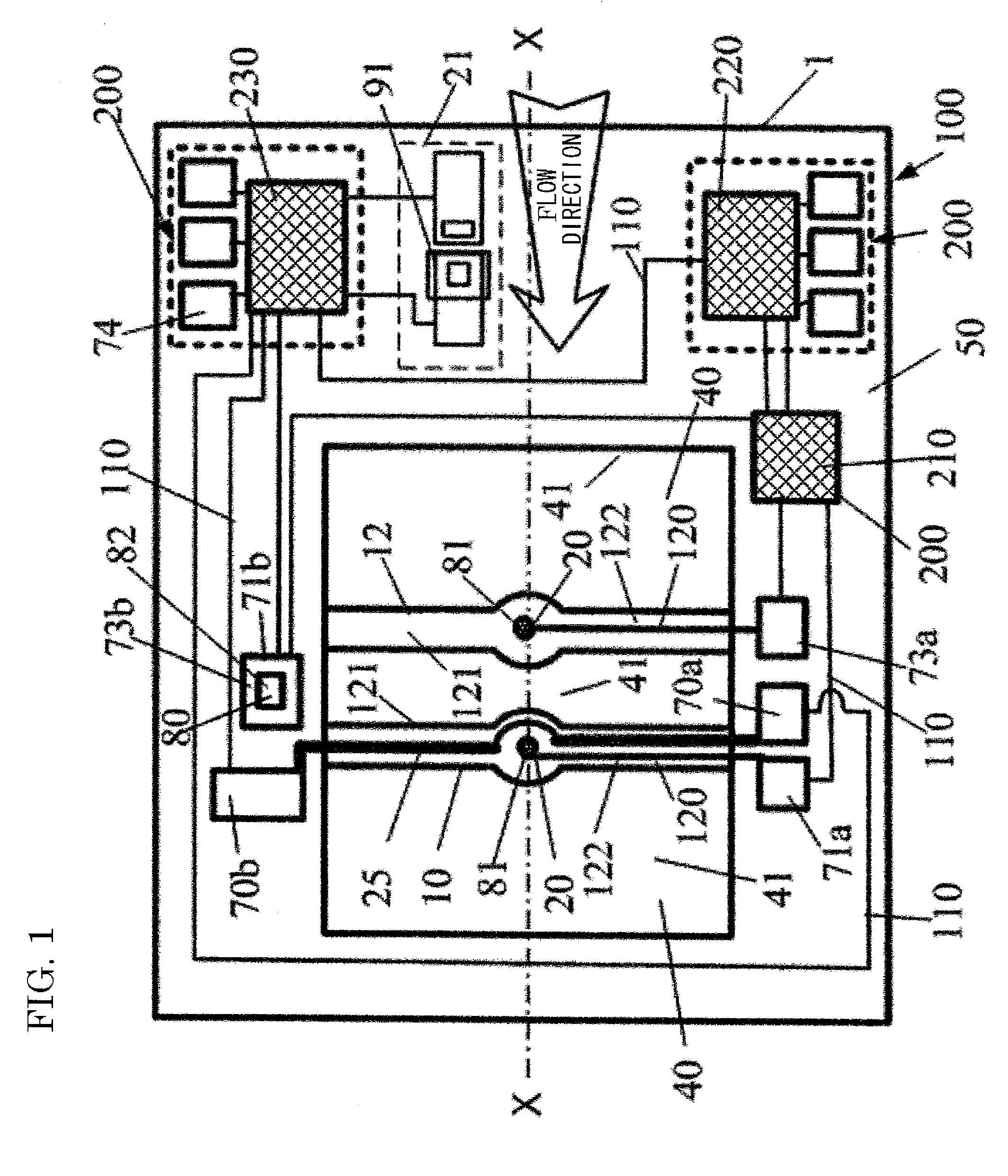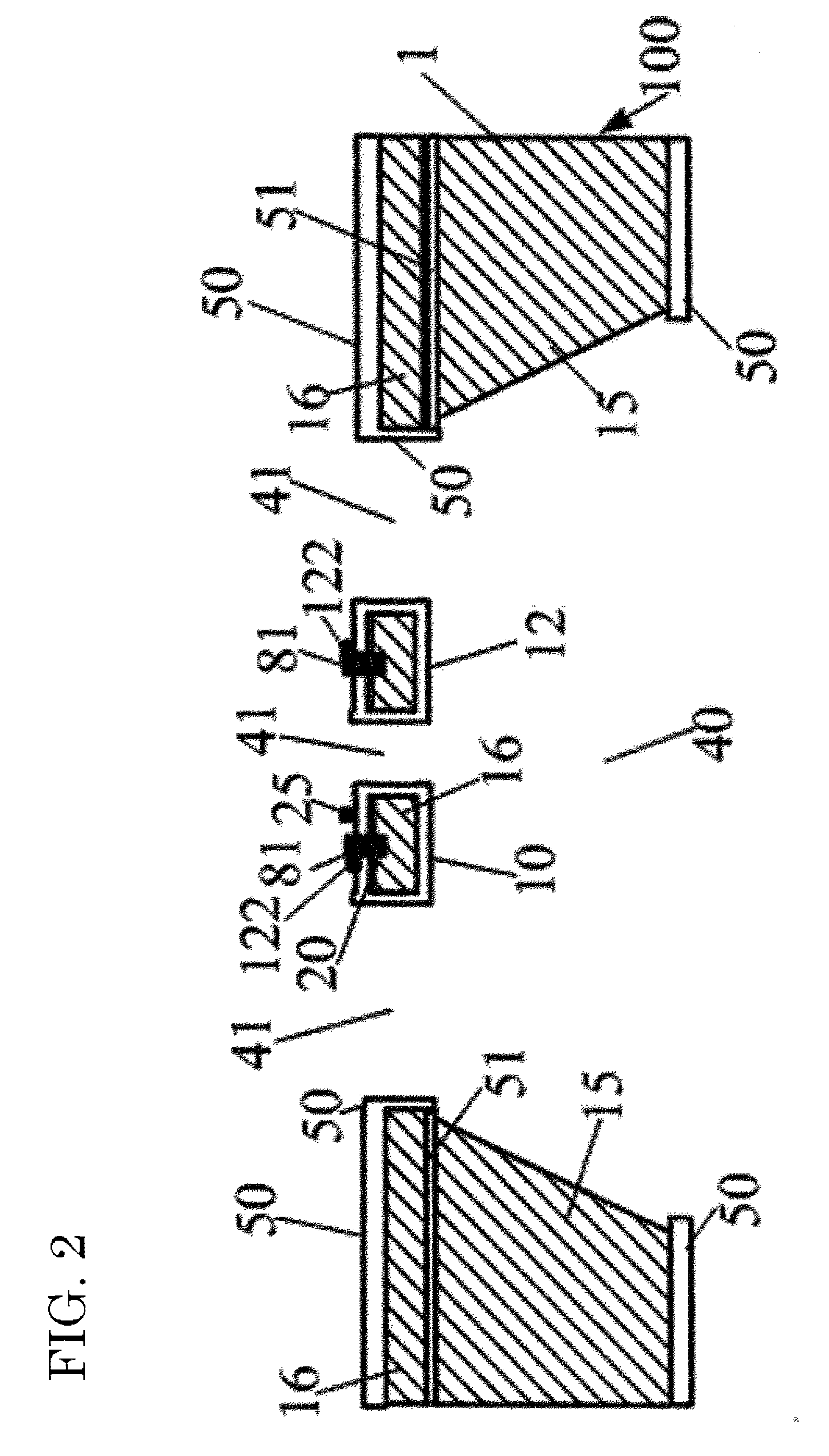Heat conduction-type sensor for calibrating effects of temperature and type of fluid, and thermal flow sensor and thermal barometric sensor using this sensor
a technology of temperature and type of fluid, conduction-type sensor, applied in the direction of heat measurement, fluid pressure measurement by thermal means, instruments, etc., can solve the problems of inability to measure fine temperature differences, complicated temperature correction, and flow sensors that are expensive, etc., to achieve small and inexpensive thermal flow sensors, easy formation, and reduced effects.
- Summary
- Abstract
- Description
- Claims
- Application Information
AI Technical Summary
Benefits of technology
Problems solved by technology
Method used
Image
Examples
example 1
[0139]FIG. 1 is a plan schematic view of a sensor chip showing an example of a heat conduction-type sensor according to the present invention, and FIG. 2 is a cross-sectional schematic view taken along a cross section X-X. In this example, a semiconductor silicon substrate 1 is used as a heat conduction-type sensor according to the present invention, and there is shown an example that an amplifier 210, an arithmetic circuit 220, and a control circuit 230 which are primary parts as calibration circuit means 200 for calibrating effects of a type or a temperature of a measurement target fluid are formed and provided on this substrate 1. Further, this is a situation where an SOI substrate as the substrate 1 is used and applied to a thermal flow sensor but it can be likewise embodied as a thermal barometric sensor as it is.
[0140]In the SOI substrate as the substrate 1, since a BOX layer 51 as a buried insulating layer is present below an SOI layer 16, the SOI layer 16 or an underlying su...
example 2
[0149]The heat conduction-type sensor chip 100 shown in FIG. 1 and FIG. 2 in the foregoing example can be used and embodied as a simple thermal barometric sensor. A description will be given as to an example that the heat conduction-type sensor depicted in FIG. 1 and FIG. 2 of the present invention is embodied as the thermal barometric sensor. In the thermal barometric sensor, as different from the application to the thermal flow sensor in Example 1, even if a measurement target fluid has no flow or if it has a flow, a mesh cover or the like is directly disposed to a thin film 10 and a thin film 12 as sensing portions of a sensor chip so that an air current cannot reach these films, and measurement is carried out in a state that the flow is blocked. Therefore, when embodying this thermal barometric sensor, the above Expression 1 is applied. Further, a heat transfer coefficient h of a gas is a function of a type and a temperature Ta of the gas and an atmospheric pressure. First, a te...
example 3
[0152]FIG. 3 is a plan schematic view of a heat conduction-type sensor chip showing another example of the heat-conduction type sensor according to the present invention in which an amplifier 210, an arithmetic circuit 220, and a control circuit 230 as primary parts of a calibration circuit means 200 are provided outside rather than being formed on the heat conduction-type sensor chip 100, but instead respective electrode pads 70a, 70b, 71a, 71b, and others are provided on the heat conduction-type sensor chip 100 in such a manner that they can be also used as calibration circuit terminals 75 for the calibration circuit means 200 provided outside to enable supply / reception of power or communication with the calibration circuit means 200 provided outside. Further, as different from the example of the heat conduction-type sensor chip 100 depicted in FIG. 3, FIG. 4 shows that a thin film 12 is constituted of a cantilever 46 and has a hot junction 81 of a thin-film thermocouple 120 as a ...
PUM
| Property | Measurement | Unit |
|---|---|---|
| heat transfer coefficients | aaaaa | aaaaa |
| temperature | aaaaa | aaaaa |
| temperatures | aaaaa | aaaaa |
Abstract
Description
Claims
Application Information
 Login to View More
Login to View More - R&D
- Intellectual Property
- Life Sciences
- Materials
- Tech Scout
- Unparalleled Data Quality
- Higher Quality Content
- 60% Fewer Hallucinations
Browse by: Latest US Patents, China's latest patents, Technical Efficacy Thesaurus, Application Domain, Technology Topic, Popular Technical Reports.
© 2025 PatSnap. All rights reserved.Legal|Privacy policy|Modern Slavery Act Transparency Statement|Sitemap|About US| Contact US: help@patsnap.com



